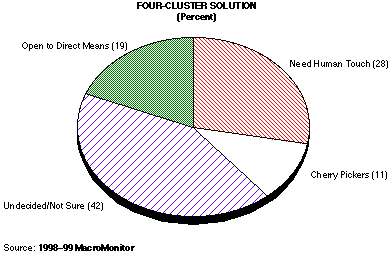Marketing Financial Services: In-Person Selling versus Direct Marketing MacroMonitor Marketing Report Vol. IV, No. 7 July 2000
Financial institutions need to provide financial products and services through different channels of delivery to meet the different needs of customers. By identifying which types of customers desire which financial products and services through face-to-face interaction versus direct meansin effect, by learning to deliver the right mix of financial products and services through the right channels to the right segments of customersinstitutions should be able to market their services more effectively.
Substantial variation exists in consumer preferences for particular channels of delivery across different types of financial products and services. Consumers prefer human interactions when buying other loan products and services, such as consumer loans, home equity loans, and lines of credit. Interestingly, consumers are more open to purchasing property/casualty insurance through direct means. Investment products and services showed more diversity: Consumers are more open to obtaining stocks, bonds, and mutual funds through direct means than other investment products such as annuities, packaged accounts, and asset-management accounts. Importantly, significant numbers of households show no strong preference.

Using consumers' preference for face-to-face interactions and direct means across 15 different financial products and services, MacroMonitor groups respondents into four clusters.
Substantial variation exists in consumer preferences for particular channels of delivery across different types of financial products and services. Consumers prefer human interactions when buying other loan products and services, such as consumer loans, home equity loans, and lines of credit. Interestingly, consumers are more open to purchasing property/casualty insurance through direct means. Investment products and services showed more diversity: Consumers are more open to obtaining stocks, bonds, and mutual funds through direct means than other investment products such as annuities, packaged accounts, and asset-management accounts. Importantly, significant numbers of households show no strong preference.

Using consumers' preference for face-to-face interactions and direct means across 15 different financial products and services, MacroMonitor groups respondents into four clusters.
- Need Human Touch (NHT). This group's demographics mirror those of all households, suggesting that no certain demographic segment would not appreciate human interaction.
- Open to Direct Means (ODM). This group is younger, more affluent, and more educated than others.
- Undecided/Not Sure. The Undecideds tend to be older and to have lower income and education.
- Cherry Pickers. The group tends to be middle-aged and middle income, with at least a high school education and with a greater proportion of married households and fewer widowed households.